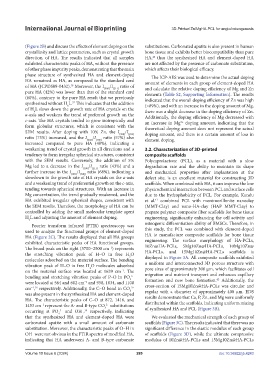Page 297 - IJB-10-6
P. 297
International Journal of Bioprinting 3D-Printed Zn/MgHA-PCL for angio/osteogenesis
(Figure 2B) and discuss the effects of element doping on the substitutions. Carbonated apatite is also present in human
crystallinity and lattice parameters, such as crystal growth bone tissue and exhibits better biocompatibility than pure
direction, of HA. The results indicated that all samples HA, thus the synthesized HA and element-doped HA
40
exhibited characteristic peaks of HA, without the presence are not affected by the presence of carbonate substitution,
of other phase impurity peaks, demonstrating that the main which affects their biological efficacy.
phase structure of synthesized HA and element-doped The ICP-AES was used to determine the actual doping
HA remained as HA, as compared to the standard card amount of elements in each group of element-doped HA
38
of HA (JCPDS09-0432). Moreover, the I (300) /I (211) ratio of and calculate the relative doping efficiency of Mg and Zn
pure HA (42%) was lower than that of the standard card elements (Table S2, Supporting Information). The results
(60%), contrary to the pure HA result that we previously indicated that the overall doping efficiency of Zn was high
synthesized without H L. This indicates that the addition (>89%), and with an increase in the doping amount of Mg,
37
6
of H L slows down the growth rate of HA crystals on the there was a slight decrease in the doping efficiency of Zn.
6
a-axis and weakens the trend of preferred growth on the Additionally, the doping efficiency of Mg decreased with
c-axis. The HA crystals tended to grow isotropically and an increase in Mg doping amount, indicating that the
2+
form globular structures, which is consistent with the theoretical doping amount does not represent the actual
SEM results. After doping with 10% Zn, the I (300) /I (211) doping amount, and there is a certain amount of loss in
ratio (73%) increased, and the I (002) /I (300) ratio (57%) also element doping.
increased compared to pure HA (48%), indicating a
weakening trend of crystal growth in all directions and a 3.2. Characterization of 3D-printed
tendency to form irregular spherical structures, consistent composite scaffolds
with the SEM results. Conversely, the addition of 5% Polycaprolactone (PCL), as a material with a slow
Mg led to a decrease in the I (300) /I (211) ratio (43%) and a degradation rate and the ability to maintain its shape
further increase in the I (002) /I (300) ratio (68%), indicating a and mechanical properties after implantation at the
slowdown in the growth rate of HA crystals on the a-axis defect site, is an excellent material for constructing 3D
and a weakening trend of preferential growth on the c-axis, scaffolds. When combined with HA, it can improve the low
tending towards spherical structures. With an increase in physicochemical interaction between PCL and surface cells
Mg concentration, the trend gradually weakened, and the due to the hydrophobicity of PCL. For example, Kundu
HA exhibited irregular spherical shapes, consistent with et al. combined PCL with montmorillonite nanoclay
41
the SEM results. Therefore, the morphology of HA can be (MMT-Clay) and nano-HA-clay (HAP MMT-Clay) to
controlled by adding the small molecular template agent prepare polymer composite fiber scaffolds for bone tissue
H L and adjusting the amount of element doping. engineering, significantly enhancing the cell activity and
6
Fourier transform infrared (FTIR) spectroscopy was osteogenic differentiation ability of BMSCs. Therefore, in
used to analyze the functional groups of element-doped this study, the PCL was combined with element-doped
HA (Figure 2C). The results displayed that all HA groups HA to manufacture composite scaffolds for bone tissue
exhibited characteristic peaks of HA functional groups. engineering. The surface morphology of HA-PCLs,
The broad peak on the right (3700–2500 cm ) represents 10Zn@HA-PCLs, 5Mg10Zn@HA-PCLs, 10Mg10Zn@
−1
the stretching vibration peak of H–O in free H O HA-PCLs, and 15Mg10Zn@HA-PCLs scaffolds is
2
molecules adsorbed on the material surface. The bending displayed in Figure 3A. All composite scaffolds exhibited
vibration peak of H–O in free H O molecules adsorbed a uniform and interconnected 3D porous structure with
2
on the material surface was located at 1639 cm . The pore sizes of approximately 300 μm, which facilitates cell
−1
bending and stretching vibration peaks of P–O in PO migration and nutrient transport and enhances capillary
3−
4
42
were located at 564 and 602 cm and 958, 1034, and 1108 formation and new bone formation. Additionally, the
−1
cm , respectively. Additionally, the C–O bond in CO cross-section of 15Mg10Zn@HA-PCLs was circular and
−1 36
2−
3
was also present in the synthesized HA and element-doped regular with a diameter of approximately 400 μm. EDS
HA. The characteristic peaks of C–O at 872, 1416, and results demonstrate that Ca, P, Zn, and Mg were uniformly
1453 cm represent the A- and B-type CO substitutions distributed within the scaffolds, indicating uniform mixing
2−
−1
of synthesized HA and PCL (Figure 3B).
3
occurring at PO and OH , respectively, indicating
3−
− 39
4
that the synthesized HA and element-doped HA were We evaluated the mechanical strength of each group of
carbonated apatite with a small amount of carbonate scaffolds (Figure 3C). The results indicated that there was no
substitution. Moreover, the characteristic peaks of O–H in significant difference in the elastic modulus of each group
OH were not obvious in the FTIR spectra of modified HA, of scaffolds (Figure 3D), while the ultimate compressive
−
indicating that HA underwent A- and B-type carbonate modulus of 10Zn@HA-PCLs and 15Mg10Zn@HA-PCLs
Volume 10 Issue 6 (2024) 289 doi: 10.36922/ijb.4243

